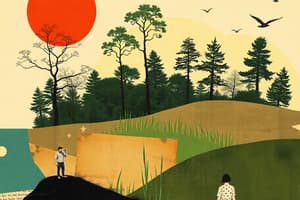Podcast
Questions and Answers
What is ecological succession primarily defined as?
What is ecological succession primarily defined as?
- The gradual and predictable change in species composition over time (correct)
- The random movement of species in an environment
- The competition between different species for resources
- The immediate recovery of a community after a disturbance
What term refers to the final community that achieves equilibrium with the environment?
What term refers to the final community that achieves equilibrium with the environment?
- Seral stage
- Pioneer community
- Transitional community
- Climax community (correct)
Which of the following does NOT characterize ecological succession?
Which of the following does NOT characterize ecological succession?
- Development of diverse organisms gradually
- Increase in total biomass during succession
- Change in community composition over time
- Decrease in the number of species over time (correct)
Primary succession is best described as occurring in which of the following areas?
Primary succession is best described as occurring in which of the following areas?
What is NOT a factor that influences the speed of community establishment during succession?
What is NOT a factor that influences the speed of community establishment during succession?
What is the primary characteristic of secondary succession?
What is the primary characteristic of secondary succession?
What type of succession occurs in very wet areas?
What type of succession occurs in very wet areas?
Which species are typically the first to colonize barren areas in primary succession?
Which species are typically the first to colonize barren areas in primary succession?
What is the end result of both hydrarch and xerarch successions?
What is the end result of both hydrarch and xerarch successions?
Which factor can reverse a stage of ecological succession?
Which factor can reverse a stage of ecological succession?
Study Notes
Ecological Succession
- Communities undergo constant changes in composition and structure in response to environmental conditions over time, known as ecological succession.
- This process is orderly and sequential, ultimately leading to a stable climax community that is in equilibrium with the environment.
- Succession involves the colonization of certain species while populations of others may decline or vanish.
- The entire sequence of changing communities is termed "sere," and each transitional community is referred to as a "seral stage" or "seral community."
- In succession, there is typically an increase in species diversity, organims' population numbers, and total biomass.
Types of Succession
- Primary Succession occurs in lifeless areas, such as bare rock, newly cooled lava, or newly created ponds, where no prior life existed.
- Secondary Succession takes place in areas where existing communities have been disrupted, such as abandoned farmland or after a forest is cleared or burned.
- Primary succession is slower due to the need for soil formation, taking hundreds to thousands of years, whereas secondary succession is more rapid since some soil is already present.
Plant Succession
- Plant succession can be categorized as either hydrarch (wet areas) or xerarch (dry areas).
- Hydrarch succession progresses from hydric (wet conditions) to mesic (medium water conditions), while xerarch succession moves from xeric (dry conditions) to mesic.
- Pioneer species are the first to colonize barren areas; in primary succession on rocks, these include lichens that help in rock weathering and soil formation.
- After pioneers, pioneer plants like bryophytes establish, leading to higher plants and ultimately reaching a stable climax forest.
- In aquatic environments, primary succession begins with phytoplankton, followed by rooted and floating plants, marshes, and finally trees, converting water bodies into land over time.
Nutrient Cycling
- Nutrient cycling is critical for the growth, reproduction, and regulation of body functions in organisms, involving the movement of elements like nitrogen, carbon, and phosphorus.
- The standing state refers to the amount of nutrients in soil, varying across ecosystems and seasons.
- Nutrient cycling, also known as biogeochemical cycles, is the continuous recycling of nutrients through ecosystem components.
- Nutrient cycles are classified as gaseous (e.g., nitrogen, carbon cycles) with reservoirs in the atmosphere, and sedimentary (e.g., sulfur, phosphorus cycles) with reservoirs in Earth's crust.
- Environmental factors like soil composition, moisture, pH, and temperature regulate the nutrient release rates within ecosystems.
Studying That Suits You
Use AI to generate personalized quizzes and flashcards to suit your learning preferences.
Related Documents
Description
This quiz explores the concept of ecological succession, focusing on how community composition and structure change over time in response to environmental conditions. Building on the ideas presented in Chapter 13, it will enhance your understanding of population and community dynamics.




